Four forces compete for blockchain + supply chain finance. What can a pure technology company rely on to obtain a market?
On August 26, the State Council issued six new free trade zone plans, and the blockchain and supply chain construction were highlighted. On the same day, 51 central enterprises signed a contract for the mutual recognition of the commercial acceptance bills of the central enterprises in Beijing. The representatives of the members of the mutual recognition alliance also signed the “Zhuzhutong” cooperation convention, which will effectively integrate the central and industrial enterprises.
Now, several government agencies and organizations are leading the way to encourage companies to use new technology to develop supply chain finance. iResearch expects that by 2023, the blockchain will increase the overall market penetration of supply chain finance by 28.3%; and bring about 3.6 trillion market size increments to the supply chain financial market. Blockchain + supply chain finance is also being mentioned more as a strategic development plan.
However, the inter-chain pulse observation recently found that the supply chain finances have begun to show that the blockchain-original enterprises that laid out supply chain finance earlier, such as Bubi and easy-to-see blocks, lacked in the new round of development. At the same time, some core enterprises in the supply chain have begun to actively adopt blockchain technology to lay out supply chain finance; while financial institutions such as technology companies and banks are also deploying new businesses one after another; the quadrilateral pattern of new battlefield finance supply chain Initial formation.
At the same time, financial institutions such as core enterprises and banks have occupied more business scenarios in supply chain finance. Therefore, the implementation of “chain reform” can occupy the market more quickly. Zhongan Technology said to the pulse of the chain, the industry chain ecology is the direction of future supply chain finance development. “Overall, the business scenario is still a necessary and sufficient condition for the development of supply chain finance. Without the soil, the beautiful flowers are just a flash in the pan.”
- RightBTC (R network) won the huge investment of angel investor Bao Erye, completed the 3.0 version upgrade
- How far is it from the era of “People Bitcoin Payments”? As early as 2011, there were encrypted payment applications.
- Xiao Lei: The rumor is very subtle, Tencent and Ali will participate in the central bank's digital currency issuance.
Supply chain finance is still the focus of the focus
Previously, the inter-chain pulse combed the blockchain application projects disclosed in the first half of 2019, with the highest proportion of financial products, a total of 89. Among them, supply chain finance (including trade loans) and cross-border payment/transaction/settlement are the most widely used scenarios, each with 18 landing applications. In the newly disclosed projects in July and August, the application of supply chain finance is also infrequent.
Mutual chain pulse statistics 7. The blockchain + supply chain financial application that landed in August and August. Recently, there have been many projects in the supply chain finance at home and abroad, and the lead subject has also shown a diversified trend.
On August 9th, Xiong'an New District landed the first single blockchain technology to support the financing leasing business of the small and medium-sized micro-enterprise Pratt & Whitney Finance. The project is the first single of “Chongqing Jiaoxiong Leasing Co., Ltd.” +Supply Chain" business applications. On August 1, Tencent Micro Enterprise Chain and Standard Chartered Bank cooperated in the first blockchain supply chain financial business. At the end of July, Ant Financial Services completed the first financing business on the “Double Chain Link”.
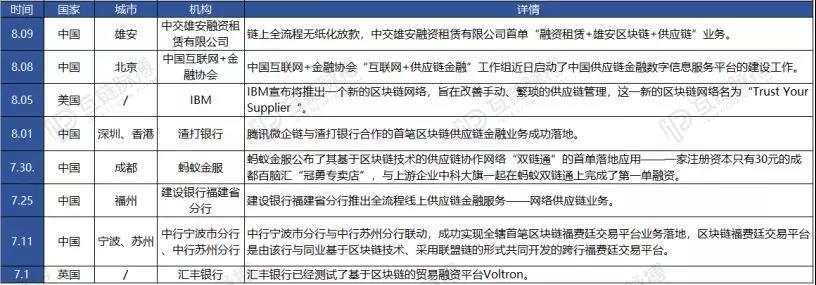
At the same time, many places are also introducing policies to support the nature of encouragement and promote the development of blockchain + supply chain finance.
On August 21, 2019, the Financial Services Bureau of Zhuhai Hengqin New District released the "Zhuhai-Macau" Blockchain + Featured Finance White Paper. As mentioned in the white paper, the combination of blockchain technology and supply chain finance is the regenerative value of enabling finance. Blockchain+supply chain finance will be one of the key directions for the future development of blockchain in Zhuhai-Macau.
On January 16, 2019, the Financial Development Service Office of the Shenzhen Municipal People's Government issued the "Opinions on Promoting the Development of Supply Chain Finance in Shenzhen". The opinion pointed out that it is necessary to make full use of technologies such as the Internet and blockchain to connect various types of supply chain finance. The core enterprise platform of the main and supply chain.
Blockchain is not enough for technology companies, technology companies are catching up
However, compared with the positive development of the overall environment, the domestic enterprises that combined blockchain technology and supply chain finance earlier failed to keep up with the new round of development boom. As early as 2016, blockchain start-ups have completed their application in the supply chain finance field. In 2017, they ushered in a small climax, but in 2019 they showed signs of decline.
In 2016, the Bubi blockchain has successively entered into cooperation with Qianxiang and Handan Iron and Steel Co., respectively to create a financial platform for the supply chain of gold and jewelry Zhanghong, and a B2B platform and supply chain financial system for the steel pipe industry. Shang Hongwu, head of the operation of the financial sector of the Bubi blockchain supply chain, said that after the open source platform of Bobby in July 2016, it has been thinking about landing issues and discussing how to commercialize the feasibility study results. From the results, Bubbi’s choice at the time was supply chain finance.
In addition to the Bubi blockchain, there are several blockchain platforms on the line to supply chain financial products in 2017. Supply chain financial service platform Xingbei cloud chain released; interesting chain successively cooperated with Agricultural Bank, Huawei, etc., launched a variety of supply chain wage products; easy to see shares cooperation IBM China Research Institute jointly released supply chain financial service system "easy to see block ", and completed the launch of hundreds of millions of yuan in three months.
It is worth noting that this batch can be regarded as the first batch of enterprises in China to start doing supply chain finance, but now it is difficult to trace it.
The introduction of the development of its products on the Zeno website stopped in August last year. According to the 2018 annual report disclosed by the company in the first half of the year, it is easy to see that it is based on supply chain management and supplemented by commercial factoring to vigorously develop supply chain financial services. However, in response to the exchange inquiry, the blockchain did not have a significant impact on the performance and reminded investors to pay attention to the risks.
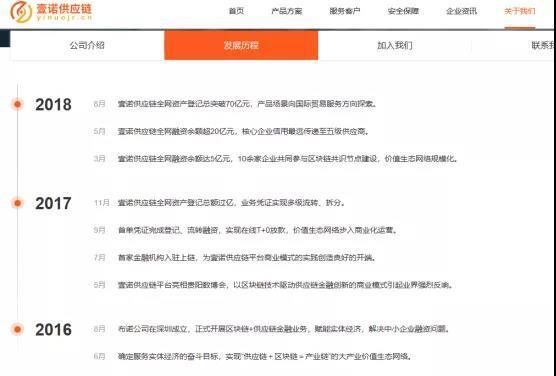
Inter-chain pulse incomplete statistics, from 2012 to 2019, four companies including Bubbi, Fun Chain, Complex Beauty, and Wanxiang Blockchain, the total number of supply chain financial projects disclosed each year is 2, 11, 6, and 1, respectively. One.
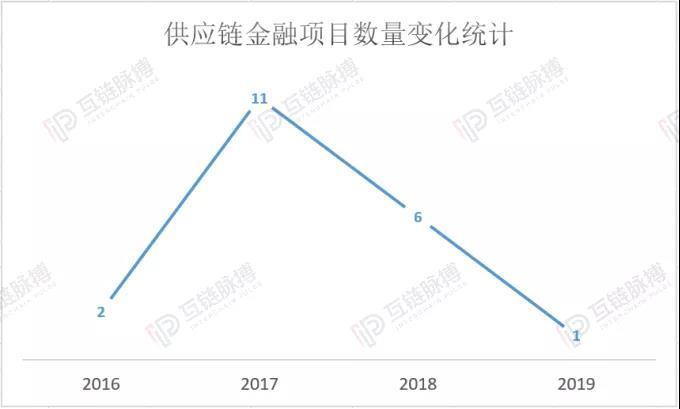
From the projects of cooperation between companies such as Bubi and the interesting chain, the chain of links found that the blockchain enterprise will choose to cooperate with some financial technology companies to build a platform, and then provide financing services for small and medium-sized enterprises. In June 2018, Fun Chain and West American Factoring launched the Western American Supply Chain Platform to provide integrated financial services to small and medium-sized suppliers on the platform. In March of this year, Western American Factoring acted as the issuer and issued shelves on the Shanghai Stock Exchange. Private construction enterprise supply chain finance ABS.
Gradually, the role of financial technology companies in blockchain + supply chain finance has become increasingly important.
In November 2017, Zhongan Technology combined medical chain technology, built a “double-chain financial asset transfer platform” around the medical supply chain, with large medical device manufacturers in the pharmaceutical industry as the core enterprises, linking financial institutions to its upstream multi-level supply. The provider provides the transfer payment and financing services for accounts receivable.
Zhongan Technology is one of the first financial technology companies in China to conduct blockchain technology research and technology landing business scene exploration. It has a number of technical patents in blockchain technology, and its own blockchain technology platform brand “Anlian Chain” The cloud also released several series of products. Different from other blockchain technology companies, Zhongan Technology can provide partners with comprehensive business and technical solution output in supply chain financial business planning consultation, blockchain technology platform and business operation, helping partners to quickly supply the supply chain. Financial services.
Based on this, Zhongan's blockchain + supply chain finance business has been applied in insurance, construction, medicine, e-commerce and other industries, and is deploying a wider range of application scenarios. Previously, the "double-chain financial assets flow" built by the joint medical chain technology. The platform has also made new progress.
In October 2018, Zhongan Science and Technology released the White Paper on Insurance Pass Based on Blockchain Assets Agreement, proposing an open asset agreement and a roadmap for the economy. In April 2019, True Fruit Technology (formerly Medical Chain Technology) announced that it has achieved a breakthrough based on the “Xintong+” and the data intelligent credit management platform “Xinxin+”. A new model of supply chain finance in which data systems are guaranteed. In May, at the 5th China Digital Innovation Exhibition and Chief Information Officer Summit (CDIE), Zhongan launched the accounts receivable pass and warehouse receipt pass.
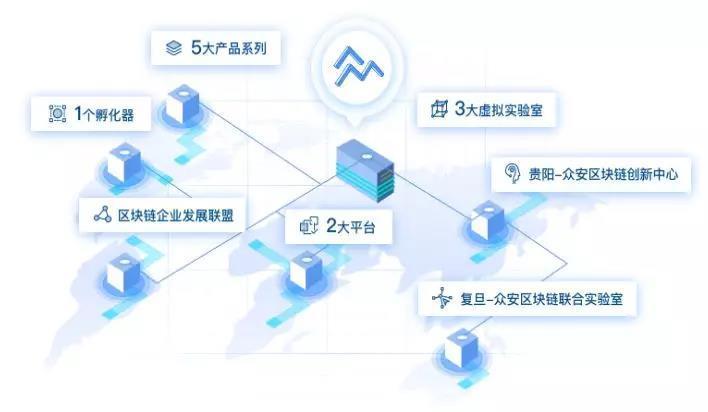
According to the relevant person in charge of Zhong'an, Zhongan is pushing the application of supply chain financial solutions in the fields of automobile manufacturing, home appliances, electronics manufacturing, medicine, construction, logistics and transportation.
Core companies use blockchain technology to pull up moats
In view of the supply chain financial business of integrated blockchain enterprises, the earliest blockchain enterprises in the supply chain financial market may be cold, and may also be related to their business models.
In the supply chain finance business, blockchain enterprises tend to focus on the financing and circulation of accounts receivable; the core enterprises have recently exerted the platform construction trend of ABS and other platforms, and integrated into the blockchain technology and self-contained system; the financial institutions led by banks The business is fully rolled out and is also involved in more “unpopular” applications such as Fufeiyan; technology companies, especially financial technology companies, also occupy more market share with “cross-border” resources and experience.
In comparison, a simple blockchain technology company is difficult to compete with other three types of companies in terms of resources, and the technical application scenarios are relatively simple.
The layout of blockchain ventures in supply chain finance is more focused on accounts receivable financing/consignment. The complex US supply chain financial solution is based on the white strip system, and the accounts receivable of the interesting chain are easily carried out through the “golden ticket” system, which are essentially the deformation of the commercial acceptance bill. With the help of blockchain technology, the splitting and circulation of bills can be realized, which is convenient for small and medium-sized enterprises to finance.
McKinsey & Co. consults that there are currently $2 trillion in credit account idle funds worldwide. If this financing and relatively safe receivables are effectively passed through supply chain finance, the world can get an additional $20 billion in potential revenue. Statistics from the National Bureau of Statistics also show that as of July 2018, the accounts receivable of Chinese companies were 13.93 trillion yuan. It is estimated that by 2020, China's supply chain financial market will reach 27 trillion yuan.
Although the size of the accounts receivable financing market continues to expand, compared with the traditional trade financing based on factoring and cargo, supply chain financing is more a systematic financing between core enterprises and banks. arrangement. This also means that blockchain companies will encounter the impact of core companies in the supply chain.

On March 1, Suning Financial issued the first supply chain financial ABS. On August 1, Tencent's “Supply Chain Finance + Blockchain + ABS Platform” micro-enterprise chain and Standard Chartered Bank cooperated in the first blockchain supply chain financial business.
On December 18, 2018, Xiaoman Finance, as a technical service provider, participated in the “China-Tianjin Tianfeng-Jinbaobei Supply Chain Finance” supply chain finance ABS issue, with a total issued size of 260 million yuan. The basic assets were the supply of Poly Company. The merchants provide goods or services to the subsidiaries of China Hongqiao Altar Co., Ltd., and enjoy the unearned receivables claims. On September 19, 2018, the financial account book was launched on the ALFA (Alpha) intelligent ABS platform.
Financial account-paying investment accountant CEO Huang Shaoyu once said that it is necessary to rebuild the trust mechanism by building a blockchain + ABS. He believes that the characteristics of the blockchain effectively solve the information synchronization and non-tampering of the information transmission mechanism. By reshaping the trust mechanism in the ABS scenario, it will be of great help to the original rights holders to better obtain the trust of investors.
In addition, large financial institutions can land more business scenarios in supply chain finance. In the first half of the year, a number of banks took the lead in laying out the blockchain for the benefit of the transaction, while the Fufeiyan business was slightly weaker in the supply chain financial layout of the blockchain technology company.
On May 22, Guilin Bank accessed the “Foyi Chain” blockchain Forfeiting platform. On April 11, Suning Bank completed the first blockchain Forfeiting (BCF) business transaction, the counterparty was the Jiangsu Branch of China Construction Bank, with a target amount of 100 million yuan. On January 22, CITIC Bank and Bank of China and Minsheng Bank jointly developed the blockchain Forfeiting trading platform in Jinan Branch.
Zhongan Technology told the inter-chain pulse that some blockchain+supply chain projects have stalled for four reasons: one is the lack of business scenarios, it is difficult to obtain support from the core enterprise's main industry; the second is the lack of business operation capability and lack of systemization. The business operation management organization failed to effectively promote the products in the upstream and downstream enterprises; the third is that the capital cost is too high, resulting in the price of the financing enterprise is not attractive; Fourth, the industry selection is not suitable, the supply chain finance is currently in the industry Not universal.
Judging from the pain points raised by Zhongan Technology, both the core enterprises and financial institutions in the industry chain have greater advantages in business scenarios and operations, as well as capital flows.
Digital currency and cross-border trade may be two major breakthroughs
The market size of blockchain + supply chain finance has gradually expanded. It is worth noting that the blockchain technology originally existed to provide a decentralized solution. The pain point of supply chain finance is that it is difficult for small and medium-sized enterprises to finance, and core enterprises and banks grasp the trust relationship and capital flow in the chain. Inclusive finance is difficult to land. Nowadays, the new model of blockchain+supply chain is also being captured by core enterprises and banks. It is difficult for the blockchain enterprises to survive. Can the “decentralization” of blockchain supply chain finance be “centralized”? It is still unknown to lead.
From the perspective of the integration of blockchain technology and supply chain finance, there are still some problems. Blockchain companies, technology platforms, core enterprises, and financial institutions still face the problem of common data, and they have their own development trends, which are difficult to form. The trend of the original.
In addition, blockchain as the underlying technology, in the development and application of the supply chain, is also facing the impact of other technologies. Kemaway, a consulting firm, and JDA, a supply chain software company, released an annual survey in May. The survey asked business executives which technologies have the greatest potential impact on the supply chain and are most likely to be adopted in the future. The results show that cognitive analysis and artificial intelligence rank in the top position, and the blockchain declines year-on-year.
In this case, the blockchain will play a bigger role in technology in supply chain finance, and perhaps digital currency and cross-border trade are two important turning points.
This month, The Economist published a series of articles on global supply chain change. The article pointed out that the current global supply chain is shortening, and there is a higher demand for speed. As the global supply chain becomes shorter and faster, the demand for capital flows is bound to increase. In addition, the high tariffs brought about by the trade war have also brought greater cash flow pressure to the co-suppliers. As the core mechanism of globalization, the supply chain will also have stronger financing needs in cross-border trade.
Previously, the central bank and the foreign exchange administration had taken the lead in laying out cross-border trade services, citing blockchain technology to serve international supply chain finance.
On September 4, 2018, the People's Bank of China Digital Money Research Institute launched the “Bay Area Trade Finance Blockchain Platform”, which aims to carry out accounts receivable, trade financing and other activities. By May of this year, the platform had developed 4 applications, accessed 26 banks, generated more than 17,000 businesses, reached more than 4 billion in total finance, and had multiple patents. Now, the central bank's trade finance blockchain platform should have a trial run of the accounts receivable financing.
On March 22, 2019, the State Administration of Foreign Exchange, as the initiator, built a cross-border trade service platform, and has now opened the business scope of “export receivables financing (after delivery)” and “enterprise cross-border credit information authorization verification”. .
In addition to facilitating the expansion of supply chain financial markets in international trade, blockchain technology has recently shown that the behavior of Wal-Mart's currency is indicating that digital currency relying on blockchain technology will play a role in supply chain finance.
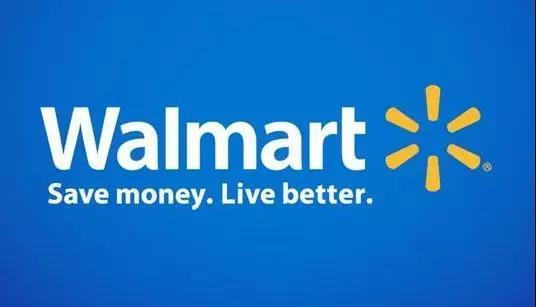
On August 1st, the Wal-Mart digital currency patent was announced, and Wal-Mart WNT could connect all links of the supply chain with Wal-Mart as its core. Wal-Mart partners can use WNT to purchase or convert cash into Wal-Mart if they accept WNT. Similarly, consumers can use WMT in WMT issuers and partner organizations to make purchases in exchange for goods and services.
In the supply chain of Wal-Mart's plan, the flow of funds is replaced to some extent by WNT, which means that Wal-Mart will have greater control over the flow of funds. Similarly, it can also play the role of supply chain finance pursuits – loosening the financial constraints of core companies and ensuring the flow of funds from suppliers and distributors.
Text | Interchain Pulse · Black Pearl
This article is [inter-chain pulse] original, the original link .
We will continue to update Blocking; if you have any questions or suggestions, please contact us!
Was this article helpful?
93 out of 132 found this helpful
Related articles
- Dig bitcoin to send altcoin, and jointly mine PoW rivers and lakes
- "Slow" public chain became a new favorite, IPC knows the production chain announced the launch of IP BANK and blockchain navigation system
- QKL123 market analysis | fried market continues, waiting for the right signal (0828)
- JP Morgan Chase Quorum blockchain platform restarts, JPM Coin is ready to go
- Facebook tired of fighting alone? Libra Association asks members to make public voices
- Report | Bitcoin market decline expected to increase, the lowest drop to $9500
- Bystack: Looking for killer "assets" (on)





